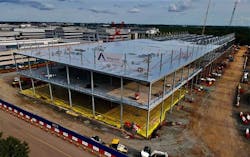Data Center Tax Revenues Provide Pandemic Cushion for Some Counties
The COVID-19 pandemic hasn’t just been a health disaster. It’s also been a devastating event for county and state budgets, as closed stores, diminished retail spending and unemployment have depressed tax revenues.
One exception has been counties with strong concentrations of data centers, which have provided social stability through the delivery of digital services, but also continued a steady flow of tax payments that have helped cushion budget impacts in places like Loudoun County in Northern Virginia.
County revenue from taxes on computer equipment inside buildings in Loudoun’s “Data Center Alley” will account for $395 million in the current fiscal year’s $1.7 billion budget, according to Assistant Director of Management and Budget Caleb Weitz. That’s up from about $280 million in fiscal 2020. a benefit of Loudoun County adding more than 3 million square feet of data center real estate in 2019. Construction has surged in the first half of 2020 as cloud platforms have raced to keep pace with pandemic-driven demand for additional capacity for digital services.
“Given the projects that are already in the pipeline, we could be at a half a billion dollars in annual tax revenues from data centers over the next three or four years,” said Buddy Rizer, the Executive Director of Economic Development for Loudoun County.
“We have a very good tax base with the data centers and federal government contractors that have been less affected by the pandemic than other sectors,” said Rizer. “It’s definitely made us a little more secure going through the pandemic.”
Major COVID-19 Economic Hit For Counties
The bottom line for most counties has been more difficult.
The pandemic will have a $202 billion impact on county budgets through fiscal year 2021, according to a report from the National Association of Counties (NACO), which says that 88 percent of U.S. counties report budget impacts from COVID-19. Those impacts include a projected $114 billion hit in revenue, $30 billion in additional expenses, and a $58 billion shortfall in funding from state governments, which are projecting a $555 million budget impact.
That’s had a pass-through impact on jobs. Local government employment decreased by 134,000 jobs in September, according to NACO, and is 939,000 jobs short of February levels.
In Northern Virginia, the world’s largest cloud computing market, developers are racing to build new IT capacity to meet extraordinary demand for computing resources due to the rapid societal shift to online services. Since March, Loudoun County has received “fast track” applications for seven construction projects, representing nearly 3 million square feet of new data center space.
“There’s a shot that this will be our biggest year yet,” said Rizer. “Everyone’s trying to work through the pandemic and keep things moving steadily ahead. We haven’t missed any deadlines. A lot of (regions) have shut down and weren’t doing site reviews. We’ve been hearing that from our data center companies trying to build in other places.
“But we haven’t stopped at all,” he added. “If anything, I think we’ve prioritized the data centers a little more right now because we know how critical they are. We also know that over the long term they’re going to be our tax base. So, we’re actually moving pretty quickly and getting (approvals) done probably a little quicker than usual.”
Economic Development Impact in Focus
While Loudoun is unique in its concentration of data centers, Rizer said there are lessons and opportunities in the experience in the Ashburn cloud cluster.
“The data center tax base is something that communities should be able to count on, because that’s going to continue to grow,” said Rizer.
Last week Facebook shared new data on the economic impact of its fleet of 13 massive data center campuses in the United States. Facebook spent $11.5 billion on data center construction and operations between 2017 and 2019.
More significantly, the analysis by RTI International found that the “multiplier effect” of the projects – the additional economic activity created by the company’s capital investments – is estimated at $18.6 billion in gross domestic product (GDP) to the U.S. economy from 2017 through 2019, or $6.2 billion per year.
About the Author



